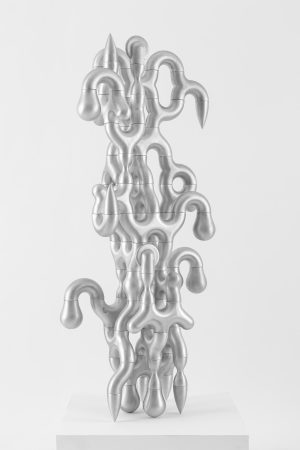
Tamás MELKOVICS
Alloy Series, Composition 14.
- Year(s)
- 2022
- Technique
- modular composition of 51 casted aluminium elements
- Size
- 86,5x54x44 cm
Artist's introduction
While watching the sculptures of Tamás Melkovics, they address me as acquaintances. Sculptures that we think are about to move, to crawl off the plinth, or perhaps even signal to us with some kind of sound. They are familiar because within the organic abstract world, the artist has found a language that speaks to our collective unconscious and evokes associations with the living world, living things, birth and movement. The art of Tamás Melkovics constantly expands the sculptural framework, but does not cross a certain boundary, it remains within the limits of the discipline. The artist graduated from the Hungarian University of Fine Arts in 2012 as a sculptor, his master was Ádám Farkas. In 2018 and 2021, he was awarded the Gyula Derkovits Fine Arts Scholarship. He exhibited at the Parthenon-Frieze Room in 2017 and at the Várfok Gallery Project Room in 2019. He has participated in several group exhibitions in Budapest, Szentendre, Székesfehérvár, Dunaújváros, Pécs and Edinburgh. In addition to private collections, his art is also included in the collections of the Ferenczy Museum Centre, the Csók István Gallery in Székesfehérvár, the Kiscelli Museum - Budapest Gallery, and the ICA-D Institute of Contemporary Art in Dunaújváros. In his creations, he seeks systems, basic rules, regularities, as if to reach back to the roots and structure of life and the perceptual world. The recurring basic modules are perhaps designed to explore these basic regularities. Movement is fundamental in his work. Even those works that are separate creatures begin a dialogue with each other. In the language of science, the sculptures can refer to fractals, to the principles of growth and evolution, the dynamics of nature, where nothing ever stops for a moment, where everything is in constant change, transformation, movement and interaction, because this is the basis of biological life. While the artworks often resemble natural forms such as trees or fruits, the anthropomorphic sculptures, which resemble Tony Cragg, question the foundations of human existence, and the complex structures that eventually settle into one final shape point to human relationships and connections. Délia Vékony
More artworks in the artist's collection »






